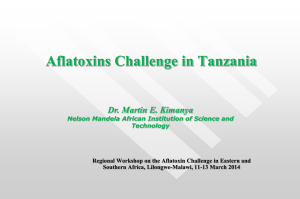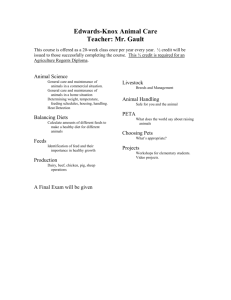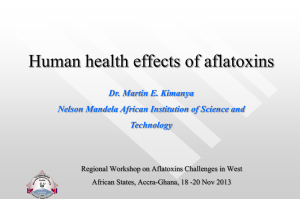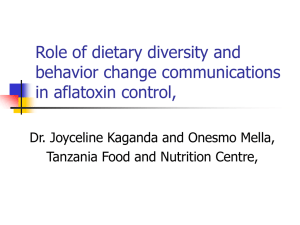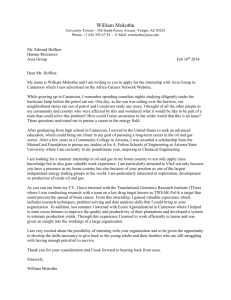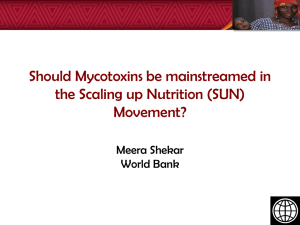Title: Occurrence of aflatoxins in foods and feedstuff: Dietary
advertisement
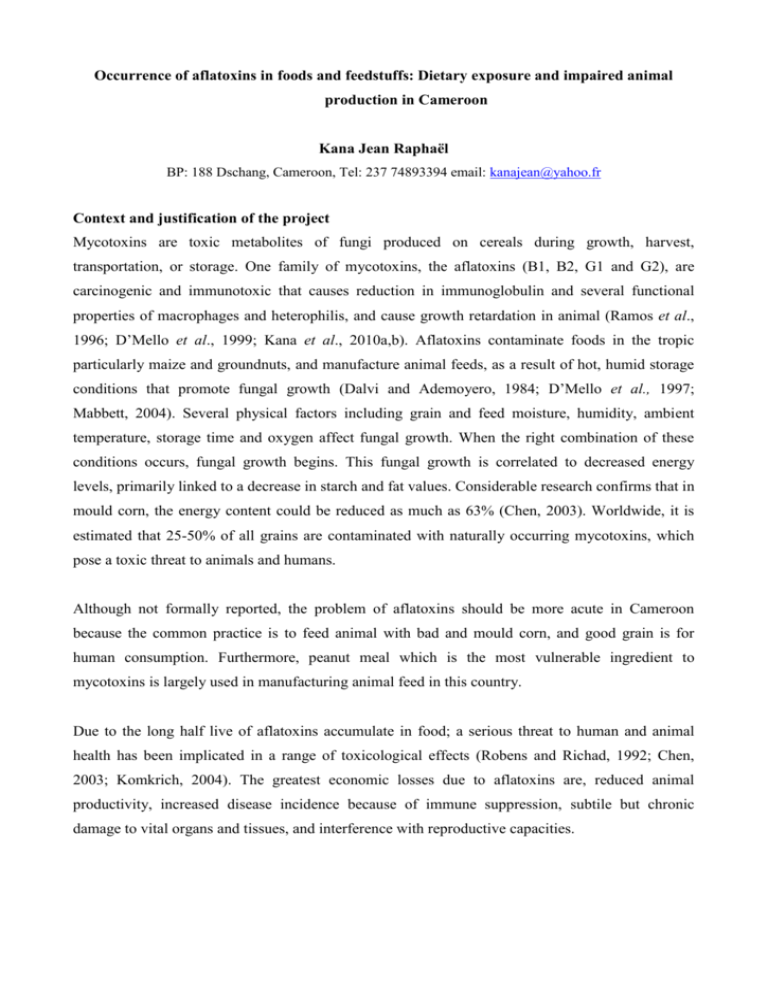
Occurrence of aflatoxins in foods and feedstuffs: Dietary exposure and impaired animal production in Cameroon Kana Jean Raphaël BP: 188 Dschang, Cameroon, Tel: 237 74893394 email: kanajean@yahoo.fr Context and justification of the project Mycotoxins are toxic metabolites of fungi produced on cereals during growth, harvest, transportation, or storage. One family of mycotoxins, the aflatoxins (B1, B2, G1 and G2), are carcinogenic and immunotoxic that causes reduction in immunoglobulin and several functional properties of macrophages and heterophilis, and cause growth retardation in animal (Ramos et al., 1996; D’Mello et al., 1999; Kana et al., 2010a,b). Aflatoxins contaminate foods in the tropic particularly maize and groundnuts, and manufacture animal feeds, as a result of hot, humid storage conditions that promote fungal growth (Dalvi and Ademoyero, 1984; D’Mello et al., 1997; Mabbett, 2004). Several physical factors including grain and feed moisture, humidity, ambient temperature, storage time and oxygen affect fungal growth. When the right combination of these conditions occurs, fungal growth begins. This fungal growth is correlated to decreased energy levels, primarily linked to a decrease in starch and fat values. Considerable research confirms that in mould corn, the energy content could be reduced as much as 63% (Chen, 2003). Worldwide, it is estimated that 25-50% of all grains are contaminated with naturally occurring mycotoxins, which pose a toxic threat to animals and humans. Although not formally reported, the problem of aflatoxins should be more acute in Cameroon because the common practice is to feed animal with bad and mould corn, and good grain is for human consumption. Furthermore, peanut meal which is the most vulnerable ingredient to mycotoxins is largely used in manufacturing animal feed in this country. Due to the long half live of aflatoxins accumulate in food; a serious threat to human and animal health has been implicated in a range of toxicological effects (Robens and Richad, 1992; Chen, 2003; Komkrich, 2004). The greatest economic losses due to aflatoxins are, reduced animal productivity, increased disease incidence because of immune suppression, subtile but chronic damage to vital organs and tissues, and interference with reproductive capacities. Objective The main objectives of this study are to evaluate the prevalence, and quantify aflatoxins in selected foods and feeds in Cameroon. The study will also characterize the effect of dietary aflatoxin exposure on animal immunocompetence, and performances as well as generate information on aflatoxin occurrence through periodical monitoring, and evolve policies which discourage the marketing of toxin contaminated foods and feeds. Methods Sample collection and analysis To evaluate the occurrence of aflatoxins, manufactured feeds and ingredients (maize, peanut meal…) use in animal feeds will be sampled from three, ecological/geographical zones of Cameroon: Savannah zone, Sudano-guinea zone, and rain forest zone. Blood sample of goat, sheep, and village chickens will be collected from West and North West Regions of Cameroon. Milk sample of breast feeding goats, sheeps, and cows will be collected from different ecological/geographical zones of Cameroon. Both serums collected from blood samples and milk will be store in labelled tubes in freezer until analysis of aflatoxin DNA adducts or albumin adducts as surrogates for genotoxicity in animals. Highly sensitive immunoassays (radioimmunoassay (RIA), enzyme-linked immunosorbent assay (ELISA), or immunoaffinity column assay (ICA) based on the affinities of the monoclonal or polyclonal antibodies or Near Infrared Spectroscopy (NIR) coupled with Ultra Performance Liquid Chromatography (UPLC) will be used for aflatoxins analysis in the host Institution. Aflatoxin content in feeds will be determine by using the Enzyme Linked Immuno-Sorbent Assay (ELISA) with appropriate immuno enzymatic kits (Transia Plate Aflatoxin B1, PT 53 2004-Rev 4) or NIR UPLC. Potential impacts/potential beneficiaries The project will generate information on aflatoxins occurrence and their impacts on animal production in Cameroon. This project will also improve the policy and institutional framework for the management of aflatoxins, and food security in Cameroon. The overall impact of the project will be the improvement of health and prosperous people resulting from the availability and marketing of aflatoxin-safe manufactured animal feeds, feeds ingredients, and animal products. The primary beneficiaries will be small and medium scale farmers, and poor households in the areas most vulnerable to aflatoxins exposure. The benefits will accrue to all stakeholders in animal feeds companies, wholesalers and retailers, and consumers of animal products. A stakeholder workshop would further ideas for institutional arrangements to further up sale dissemination of information generated from this study and provide endorsement from key stakeholders such as farmer organizations, commodity utilization sectors (feed and food industry), and policy makers. How this project links to our research interests Our research interest lies on animal nutrition with special reference to poultry nutrition. In our previous studies (Kana et al., 2010a and b) we have identified some plant charcoal that are effective in binding aflatoxins in chickens feeds in on station trials. The next steps is to develop partnerships for monitoring aflatoxins content in feeds ingredients, to assess the impacts of animal exposure to aflatoxins, to test the efficacy of low cost natural plant charcoals in large-scale field trials, and to recycle on molecular techniques in laboratory. Expected results 1-Determine occurrence of aflatoxin in feeds ingredients, and manufacture commercial feeds. 2- Determine the incidence and range of aflatoxin in animal production performances in Cameroon. 3- Initiate a project proposal on aflatoxin management with several modules: - Donor (University of Dschang, Cameroon) -Starting and ending date (Duration to define by donor and partners) -Location (Cameroon) -Partners (n/a) Note: Suggestion for appropriate planning and methodology from the host Institution experts will be welcomed. The proposed methodology is only prospective. References 1 Chen Y.J., 2003. Mould and mycotoxins: Control from grain to feeding. Feed International.24 (12): 22 - 24. 2 D’Mello J.P.F., Placinta C.M. and Macdonald A.M.C., 1999. Fusarium mycotoxins : a review of global implications for animal health, welfare and productivity. Animal Feed Science and Technology. 80: 183-205. 3 D’Mello J.P.F., Porter J.K., Macdonald A.M.C. and Placinta C.M., 1997. Fusarium mycotoxins. In: D’Mello J.P.F. (edt.), Hanbook of plant and fungal toxicants. CRC Press, Boca Raton, FL. Pp 287-301. 4 Dalvi R.R. and Ademoyero A.A., 1984. Toxic effects of aflatoxin B1 in chickens given feed contaminated with Aspergillus flavus and reduction of the toxicity by activated charcoal and some chemical agents. Avian Diseases. 28: 61-69. 5 Kana J R, Teguia A and Tchoumboue J., 2010a. The evaluation of activated dietary charcoal from Canarium schweinfurthii Engl. seed and maize cob as toxin binder in broiler chickens. Animal Health and Production in Africa. 58 (4) : 358-363. 6 Kana J R, Teguia A and Tchoumboue J., 2010b. Effect of dietary plant charcoal from Canarium schweinfurthii Engl. and maize cob on aflatoxin B1 toxicosis in broiler chickens. Livestock Research for Rural Development. 22 (4) 2010. http://www.lrrd.org/lrrd22/4/kana22077.htm 7 Komkrich P., 2004 Absorption of aflatoxine. Asian Poultry Magazine, june 2004. Pp 1-2. 8 Mabbett T., 2004 The single most serious constraint on poultry production in humid climates. Poultry International. November 2004. 43(12). 38 - 41. 9 Ramos A J, Johana F G and Hernandez E, 1996 Prevention of toxic effects of mycotoxins by means of non-nutritive absorbent compounds. Journal of Food Protection. 59 (6): 631-641. 10 Robens J.F. and Richard J.L., 1992. Aflatoxins in animal and human health. Revue of Environment Contamination and Toxicology. 127: 69-94. TIMELINE Activities Contents Duration In Cameroon Sample Duration: collection 2 months At host Institution A rapid recycling on Near Infrared Spectroscopy (NIR) and Ultra Laboratory Performance Liquid Chromatography (UPLC) will be very helpful training at host at the beginning of the stay and well appreciated, to impregnate Institution the existing materials and methodologies in the domain. Such Duration: 1 month. training would be very useful once returned back to Cameroon. This constitutes the main motivation of my application. I would Samples expect support and indications to undertake all treatments. Host Duration: analysis: Institution assistance during this stage will be of great importance 3 months for my first real laboratory work using NIR-UPLC. Data analysis: I also expect host Institution to provide softwares and assist me during data processing. This could be initiated at the host Institution in collaboration with Scientific my partners from this Institution, and continued when back in papers writing Dschang, where numbers of similar research notes done worldwide are available for discussion. Duration: 1 week.
